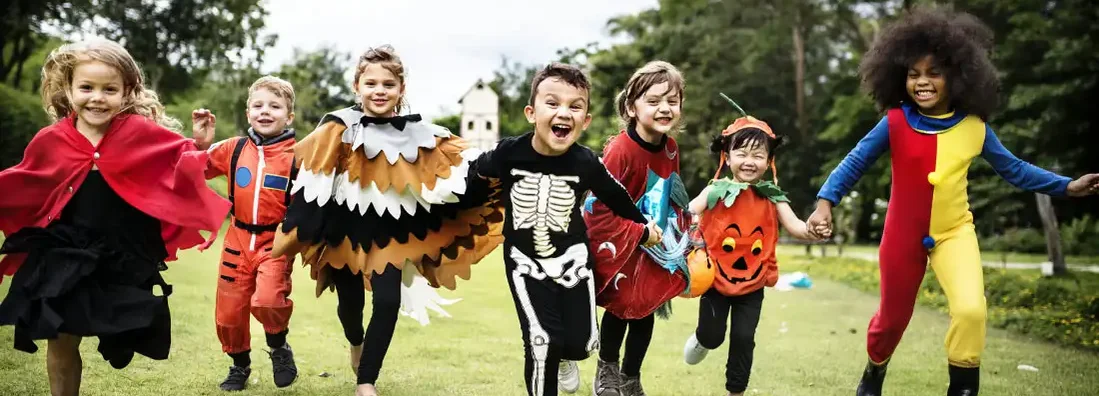10 Halloween Safety Tips for a Spooky but Peaceful Night

Cara Carlone is a licensed P&C agent with 20 years of experience. She has her P&C license in RI and TX and holds CPCU, API, and AINS designations.

Halloween is just around the corner, and many participants may not realize how frightening this spooky night could really be for their personal safety, property, or bank accounts. It's critical to be aware of potential hazards whether you're supervising children trick-or-treating or staying home to pass out candy to little costumed visitors. At the end of the night, you're hoping everyone has a satisfied sweet tooth. Filing homeowners insurance claims for liability or property damage probably isn't on your list of top priorities.
We're here to help your favorite holiday be a great success by providing some key safety tips to prevent possible disasters. You can also reach out to a local independent insurance agent to check that your home coverage is updated and comprehensive enough to cover potential mishaps. For now, start by reading our guide to the top 10 Halloween safety tips for a peaceful night.
Tips for a Safe Trick-or-Treating Experience
On Halloween night, the main event for kids is obviously trick-or-treating. But children and adults alike can be at risk when out walking the streets in search of candy. Fortunately, there are a few safety tips you can keep in mind to ensure this process stays nothing but fun.
Tip #1: Costume Safety
Halloween costumes can hide more than someone’s true identity. All disguises should be made from flame-resistant materials, not contain sharp accessories, and not be too long. Get a costume that fits your child correctly and won't pose a tripping hazard when they wear it.
Avoid masks that may obscure vision, and only use hypoallergenic makeup or face paint. Test makeup and face paint on a small area of skin well in advance and wait a day to ensure no allergic reaction occurs. Once the night is over, make sure to remove all makeup and face paint fully.
Tip #2: Stay Visible
Encourage all trick-or-treaters and adult chaperones to carry flashlights. For added safety, apply reflective tape or other light-reflecting material to costumes.
Alternatively, each kid can carry glowsticks to stay visible. This can help motorists easily spot children on sidewalks who may want to cross the street at an inappropriate place.
Tip #3: Stay Alert
The number one rule of Halloween safety is to remain on alert throughout the night. Make sure children's hearing isn’t impaired with costumes or earbuds.
Teach kids to be alert to the sounds of moving vehicles, other groups of pedestrians or bicyclists, and animals and to listen to their surroundings. Consider skipping any elements of a costume that may obstruct a child's senses.
Parents should also stay on high alert throughout the night by watching drivers on the road and other people out walking on the sidewalks. Monitor traffic and instruct kids on when it's safe to use the crosswalk. Always stay together with your group of trick-or-treaters to help ensure a safe Halloween experience.
Tip #4: Power in Numbers
When traveling on foot, walk in groups and cross only at corners and crosswalks — never between parked cars. Always choose well-lit streets, and don't visit any houses with their porch lights turned off.
If any kids break off from the group, make sure they use the buddy system and never walk alone. At least one person in each group should always have a cell phone on them in case of an emergency.
Tips for Creating a Safe Trick-or-Treating Destination
Allowing trick-or-treaters to visit your home can make Halloween one of the most exciting days of the year. But while you're preparing your Halloween decorations and treats, take some steps to help reduce the risk of injuries, property damage, fire, lawsuits, and other possible disasters.
Tip #5: Deter Unwelcomed Guests
Property vandals often strike during Halloween night's chaos. Keep outdoor lights on to scare them away. If your property remains well-lit, you can greatly reduce your chances of experiencing various property crimes like vandalism, theft, and break-ins. However, keep in mind that if your porch light is on, it signals that your home is a destination for trick-or-treaters.
Tip #6: Pet Safety
Keep your pets inside on Halloween night. The increased foot traffic during trick-or-treating can easily overstimulate animals. Warn children to stay away from animals as they go door to door.
Halloween night can be stressful, even for the friendliest creatures, including the neighborhood dogs and cats. Just one bite from an overexcited dog can lead to a costly lawsuit and a bad injury, not to mention a ruined holiday.
Tip #7: Fire Safety
Prevent fires by keeping any pumpkins containing candles at a safe distance where costumes can't be ignited, and guests or pets can't accidentally tip them over. Extinguish all candles before going to bed. Warn children in advance of the dangers of using candles and heating elements.
You can also greatly limit your fire risk by choosing alternatives to open flames. Use battery-operated or LED lights whenever possible. Many stores that sell Halloween decor sell a variety of jack-o-lantern lights. You can also get creative and light the inside of carved pumpkins with glow sticks.
Tip #8: Reduce Accident Risk
Remove or move lawn furniture, garden gnomes, or any other obstacles to avoid accidents or damage. Distracted children and parents could easily trip over lawn decorations, which could lead to injuries and possible lawsuits.
Ensure your home’s entry is in good condition, free of loose or broken pieces on stairwells. Keep walkways clear to avoid trick-or-treater and chaperone injuries on your property.
Tips for Food and Candy Safety
Of course, the great reward at the end of a successful night of trick-or-treating is a bag full of candy. Sadly, not all of these treats may be safe to consume. That's why it's critical for parents to inspect every piece of candy or food before children are allowed to eat it. Follow these simple food and candy safety tips so your kids can safely enjoy their spoils from the night.
Tip #9: Perform a Thorough Candy Inspection
Cavities and stomach aches aren’t the only candy-related risks on Halloween. Carefully inspect all trick-or-treat candy and other treats. Never eat unwrapped items, and toss any apples or home-baked goods. Watch for any choking hazards young kids and toddlers need to be aware of, such as jawbreakers.
Tip #10: Be Aware of Allergies
Food allergies have become increasingly prevalent over the years. If you'll be chaperoning a group of trick-or-treaters, be prepared with a list of all children's food allergies from their parents beforehand. Nut, gluten, and dairy allergies can turn what's meant to be a fun Halloween night into a nightmare that ends in an emergency room visit. Luckily, you can avoid this by first checking the ingredients of all wrapped candy.
Review Your Homeowners Insurance Before Halloween Night
No matter how safely you practice Halloween, there's still a risk of various disasters. From lawsuits to vandalism and beyond, you'll want to make sure your homeowners insurance is up-to-date before it's time to start carving pumpkins.
A local independent insurance agent can help you review your coverage and update your policy if necessary. They can also shop and compare quotes from several different companies for you if it's time to change your coverage. And if you're the victim of Halloween night tricks, your agent can help you file home insurance claims, too.
https://www.operationwarm.org/newsroom/blog.html/article/2022/10/27/10-halloween-safety-tips-to-protect-your-kids
